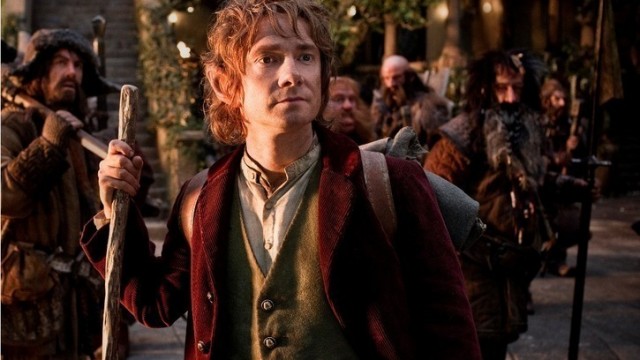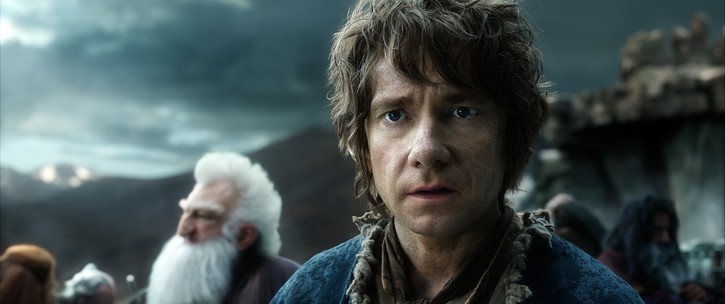As hard as it may be to believe, in about five days time, it’ll officially have been eight months since that trilogy of Hobbit movies came to an end. Yet, even with it, y’know, ending and all, news of the franchise still lurks about, with a recent development confirming that an extended cut of the final film in the series, The Battle of The Five Armies, would be rated R. That seemed like a peculiar decision to me, but then again, The Hobbit trilogy hasn’t been the kind of cinematic creation that adhered to the rules or expectations people set for them. In some ways, that’s a virtue, and in other very blatant ways, it’s certainly a foible for the massive three-film long endeavor.
Excitement abounded for the first Hobbit movie, An Unexpected Journey, and why wouldn’t it? The first Lord of The Rings film in nine years was about to arrive! The saga was back! Why, the amount of excitement in the air would have given the spirit of exuberance present at Bilbo Baggins birthday in The Fellowship of The Ring a run for its money! When I myself finally got to see this first Hobbit movie, after waiting a full year since the teaser trailer on The Adventures of Tintin whetted my anticipation, I found it to be a decent, well-made, but laggy sort of creation.
An Unexpected Journey is the set-up for what’s to come in this trilogy, and while that’s not inherently a bad stroytelling move, I couldn’t help but wonder why it lacked the razzle-dazzle of earlier Lord of The Rings movies. Exciting battle sequences and well-developed character connections from that other Middle-Earth saga had been replaced by 13 interchangeable dwarves and an Orc that looks to be made of play-doh named Azog.
None of it is truly bad, and there’s actually a number of scenes (such as when Bilbo attempts to outsmart some trolls and a riddle game between Gollum and Bilbo) that work like gangbusters. However, those high-quality scenes also come with a price, in that they just show how lackluster the rest of the motion picture is. How on Earth is anyone supposed to find the resolution of the conflict between Thorin and Azog even remotely interesting when it almost immediately follows that compelling Gollum riddle scene? The scene would have prominent flaws on its own, but they’re only highlighted by the movies stronger sequences.
By contrast, the second film of the series, The Desolation of Smaug, seemed to just say “screw it” and toss away any extraneous content and just embrace fantasy spectacle. This approach may sound like a recipe for disaster, but truthfully, this one’s my favorite of the trilogy precisely for this reason. Shapeshifting bear-people, giant spiders and dragons that sound like Benedict Cumberpatch populate the film and I can’t help but be swept up by it. Is it great cinema like the original Lord of The Rings film? Certainly not. But perhaps because its so concerned with getting to the next piece of fantasy fueled fun TDOS mostly forgoes forgettable scenes solely there to pad out the running time. Believe you me, that makes a world of difference, even if the characters that aren’t Bilbo or Gandalf remain paper-thin in terms of depth.
Of course, even in this exciting chapter of this saga, there’s that romance between one of the dwarves and Tauriel. Considering how few female characters crop up in the book version of The Hobbit, it makes sense that one of the embellishments present in a cinematic adaptation is a cast member with two x chromosomes. But instead of making one or two of the thirteen damn dwarves a woman, the film decides to create a woman in the cast whose only purpose is to fall in love with a dwarf and then bemoan the romance. How do these two fall in love after only one or two chance encounters? Why can’t the only female cast member get something interesting to do? Why does this love story literally have nothing to do with the main story? The inquiries regarding this romance just never end.
The majority of this “tragic romance” occurs in the final film in The Battle of The Armies, which, like its predecessor, piles on the action. But the inventive fantasy spectacle of the second movie is replaced by boring CGI armies colliding into each other. With the only interesting bad guy, Smaug, getting an arrow into the chest ten minutes into the movie, we’re left with only that Azog doofus and his countless soldiers as foes. With such a large battle occurring, it’s fairly obvious that a lot of character work is going to be ignored here, which is a problem when the titular battle goes on for ages and ages (Another virtue of the second movie? None of the action-heavy set pieces outstayed their welcome, unlike the content seen here).
Lack of character development becomes a problem when folks like Bard The Bowman suddenly get no conclusion to their character arc, though don’t worry folks, that Alfred guy will get tons and tons of screentime in this motion picture. No really, why the hell is Alfred in this movie? He serves no storytelling purpose as far as I can tell and he brings this overlong film (that’s ironically the shortest of the trilogy) to a grating halt whenever he pops up. The only purpose I can imagine he serves is to further boost the running time. Perhaps if the only way to get your movie past the 140 minute mark is to have a character like Alfred keep cropping up, well, maybe your feature shouldn’t be that long at all. Just a thought.
Eight months after it reached its conclusion, one can look at The Hobbit as the entire trilogy that it had always been planned as since the olden days of July 2012. As three motion pictures, only The Desolation of Smaug works as both an exciting chapter in a larger story and as a cohesive cinematic experience in its own right. Not that the other two movies are bad, but they do lack focus or interesting action and characters, which makes watching the weakest entry, The Battle of The Five Armies, more of a chore than a riveting experience. Perhaps if more attention had been paid to making characters like Tauriel more interesting instead of solely focusing on how to extend this story into three films, maybe the entire ordeal would have been more consistently entertaining. Considering the track record of the last Middle-Earth trilogy, as well as the talented cast assembled and the quality of The Desolation of Smaug, it’s a shame the entire Hobbit trilogy couldn’t be more of a cohesive enthralling entity.


